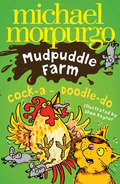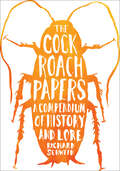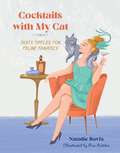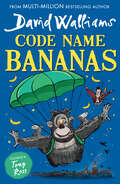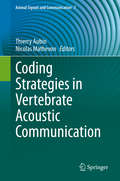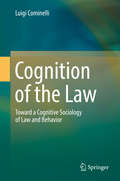- Table View
- List View
Cock-A-Doodle-Do! (Mudpuddle Farm)
by Michael MorpurgoJoin the fun on the farm! A charming story from award-winning author Michael Morpurgo, hilariously illustrated throughout by Shoo Rayner, and perfect for readers of 5 and up.
Cockadoodle-Doo, Mr Sultana! (Everystory Ser.)
by Michael MorpurgoA rich and greedy sultan meets his match in a VERY cheeky little red rooster… Hilariously wacky tale by bestselling author of War Horse.
The Cocker Spaniel: Care and Training for Home and Sport
by Janet MenziesWith many readers coming to cockers for the first time, this book offers complete guidance for their very earliest care and training at home, and then introduces both cockers and their owners to a range of different activities and competitions.Drawing on more than a quarter of a century's experience with cockers, the author takes you on a wonderful journey from the moment your puppy arrives home to the day that you start enjoying sports and activities together. The Cocker Spaniel covers every aspect of cockers, from the history of the breed to healthcare and problem-solving guides.There is also valuable information on contacting the wider cocker community and on joining groups and clubs. Many cocker owners also want to work their dog as a gundog in country sports, including field trials and working tests. With The Cocker Spaniel, the transition from family dog at home to elite performance dog in the field is seamless and straightforward to achieve. There is invaluable technical instruction on how to work your cocker in the field, as the author has achieved successfully, with five Field Trial Champions to her name.
Cockerel (Large Print)
In this image of a cockerel, its head is on the left of the page and tail on the right. There is a locator dot shown, which will be at the top left of the page when the image is the right way up. This cockerel is looking towards the left so only one eye can be found. Its beak is open. The cockerel is a fancy bird with a red comb on top of its head, and colourful feathers along its long neck. One of its two wings is shown, along with its large flamboyant tail in the top right of the image. The cockerel stands on two legs and has long toes with small claws at the end.
Cockerel (UEB Contracted)
In this image of a cockerel, its head is on the left of the page and tail on the right. There is a locator dot shown, which will be at the top left of the page when the image is the right way up. This cockerel is looking towards the left so only one eye can be found. Its beak is open. The cockerel is a fancy bird with a red comb on top of its head, and colourful feathers along its long neck. One of its two wings is shown, along with its large flamboyant tail in the top right of the image. The cockerel stands on two legs and has long toes with small claws at the end.
Cockerel (UEB Uncontracted)
In this image of a cockerel, its head is on the left of the page and tail on the right. There is a locator dot shown, which will be at the top left of the page when the image is the right way up. This cockerel is looking towards the left so only one eye can be found. Its beak is open. The cockerel is a fancy bird with a red comb on top of its head, and colourful feathers along its long neck. One of its two wings is shown, along with its large flamboyant tail in the top right of the image. The cockerel stands on two legs and has long toes with small claws at the end.
The Cockroach Papers: A Compendium of History and Lore
by Richard SchweidSkittering figures of urban legend—and a ubiquitous reality—cockroaches are nearly as abhorred as they are ancient. Even as our efforts to exterminate them have developed into ever more complex forms of chemical warfare, roaches’ basic design of six legs, two hypersensitive antennae, and one set of voracious mandibles has persisted unchanged for millions of years. But as Richard Schweid shows in The Cockroach Papers, while some species of these evolutionary superstars do indeed plague our kitchens and restaurants, exacerbate our asthma, and carry disease, our belief in their total villainy is ultimately misplaced. Traveling from New York City to Louisiana, Mexico, Nicaragua, and Morocco, Schweid blends stories of his own squirm-inducing roach encounters with meticulous research to spin a tale both humorous and harrowing. As he investigates roaches’ more nefarious interactions with our species—particularly with those of us living at the margins of society—Schweid also explores their astonishing diversity, how they mate, what they’ll eat, and what we’ve written about them (from Kafka and Nelson Algren to archy and mehitabel). Knowledge soon turns into respect, and Schweid looks beyond his own fears to arrive at an uncomfortable truth: We humans are no more peaceful, tidy, or responsible about taking care of the Earth or each other than these tiny creatures that swarm in the dark corners of our minds, homes, and cereal boxes.
The Cockroach Papers: A Compendium of History and Lore
by Richard SchweidSkittering figures of urban legend—and a ubiquitous reality—cockroaches are nearly as abhorred as they are ancient. Even as our efforts to exterminate them have developed into ever more complex forms of chemical warfare, roaches’ basic design of six legs, two hypersensitive antennae, and one set of voracious mandibles has persisted unchanged for millions of years. But as Richard Schweid shows in The Cockroach Papers, while some species of these evolutionary superstars do indeed plague our kitchens and restaurants, exacerbate our asthma, and carry disease, our belief in their total villainy is ultimately misplaced. Traveling from New York City to Louisiana, Mexico, Nicaragua, and Morocco, Schweid blends stories of his own squirm-inducing roach encounters with meticulous research to spin a tale both humorous and harrowing. As he investigates roaches’ more nefarious interactions with our species—particularly with those of us living at the margins of society—Schweid also explores their astonishing diversity, how they mate, what they’ll eat, and what we’ve written about them (from Kafka and Nelson Algren to archy and mehitabel). Knowledge soon turns into respect, and Schweid looks beyond his own fears to arrive at an uncomfortable truth: We humans are no more peaceful, tidy, or responsible about taking care of the Earth or each other than these tiny creatures that swarm in the dark corners of our minds, homes, and cereal boxes.
The Cockroach Papers: A Compendium of History and Lore
by Richard SchweidSkittering figures of urban legend—and a ubiquitous reality—cockroaches are nearly as abhorred as they are ancient. Even as our efforts to exterminate them have developed into ever more complex forms of chemical warfare, roaches’ basic design of six legs, two hypersensitive antennae, and one set of voracious mandibles has persisted unchanged for millions of years. But as Richard Schweid shows in The Cockroach Papers, while some species of these evolutionary superstars do indeed plague our kitchens and restaurants, exacerbate our asthma, and carry disease, our belief in their total villainy is ultimately misplaced. Traveling from New York City to Louisiana, Mexico, Nicaragua, and Morocco, Schweid blends stories of his own squirm-inducing roach encounters with meticulous research to spin a tale both humorous and harrowing. As he investigates roaches’ more nefarious interactions with our species—particularly with those of us living at the margins of society—Schweid also explores their astonishing diversity, how they mate, what they’ll eat, and what we’ve written about them (from Kafka and Nelson Algren to archy and mehitabel). Knowledge soon turns into respect, and Schweid looks beyond his own fears to arrive at an uncomfortable truth: We humans are no more peaceful, tidy, or responsible about taking care of the Earth or each other than these tiny creatures that swarm in the dark corners of our minds, homes, and cereal boxes.
The Cockroach Papers: A Compendium of History and Lore
by Richard SchweidSkittering figures of urban legend—and a ubiquitous reality—cockroaches are nearly as abhorred as they are ancient. Even as our efforts to exterminate them have developed into ever more complex forms of chemical warfare, roaches’ basic design of six legs, two hypersensitive antennae, and one set of voracious mandibles has persisted unchanged for millions of years. But as Richard Schweid shows in The Cockroach Papers, while some species of these evolutionary superstars do indeed plague our kitchens and restaurants, exacerbate our asthma, and carry disease, our belief in their total villainy is ultimately misplaced. Traveling from New York City to Louisiana, Mexico, Nicaragua, and Morocco, Schweid blends stories of his own squirm-inducing roach encounters with meticulous research to spin a tale both humorous and harrowing. As he investigates roaches’ more nefarious interactions with our species—particularly with those of us living at the margins of society—Schweid also explores their astonishing diversity, how they mate, what they’ll eat, and what we’ve written about them (from Kafka and Nelson Algren to archy and mehitabel). Knowledge soon turns into respect, and Schweid looks beyond his own fears to arrive at an uncomfortable truth: We humans are no more peaceful, tidy, or responsible about taking care of the Earth or each other than these tiny creatures that swarm in the dark corners of our minds, homes, and cereal boxes.
Cockroaches: Ecology, Behavior, and Natural History
by William J. Bell Louis M. Roth Christine A. NalepaThe cockroach is truly an evolutionary wonder. This definitive volume provides a complete overview of suborder Blattaria, highlighting the diversity of these amazing insects in their natural environments. Beginning with a foreword by Edward O. Wilson, the book explores the fascinating natural history and behavior of cockroaches, describing their various colors, sizes, and shapes, as well as how they move on land, in water, and through the air. In addition to habitat use, diet, reproduction, and behavior, Cockroaches covers aspects of cockroach biology, such as the relationship between cockroaches and microbes, termites as social cockroaches, and the ecological impact of the suborder. With over 100 illustrations, an expanded glossary, and an invaluable set of references, this work is destined to become the classic book on the Blattaria. Students and research entomologists can mine each chapter for new ideas, new perspectives, and new directions for future study.
Cockroaches from Jurassic sediments of the Bakhar Formation in Mongolia (SpringerBriefs in Animal Sciences)
by Peter VršanskýThis book provides essential information on 12 cockroach assemblages with more than a thousand specimens analyzed and investigates the Jurassic site in Bakhar, Mongolia, as one of the most diverse fossil insect sites worldwide. The findings presented here include 32 new cockroach species (of a total of 300 Jurassic species described worldwide). Since several individuals of each species are investigated, the book is the first that contains information on the variability of an Upper Jurassic organism. The wings of the cockroach specimen only rarely show wing deformations, suggesting that the ecological conditions at Bakhar were optimal during that time. The book’s content is clearly structured, moving from collection methods, to phylogenetic analyses, to a comparison of global fossil sites. Given its scope, the book appeals to all (Jurassic) paleontologists, botanists and paleoentomologists, as it offers an unbiased counterpart to the extensively studied Daohugou site in China. It is also useful in the mining industry, as the strata contain strategic coal (and other materials).
Cocktails with My Cat: Tasty Tipples for Feline Fanatics
by Natalie BovisFascinating feline trivia meets easy-to-make drink recipes in this tasty tome dedicated to the fluffiest, sassiest, and most independent household pet—cats!—from bestselling author, award-winning mixologist, and passionate animal advocate, Natalie Bovis. If there's one thing we know, it's that we can survive anything with a furry friend and a cocktail by our side. Enter Cocktails with My Cat, which combines our devotion to cats with celebratory drinks in this charming, pet-centric cocktail book from Natalie Bovis of The Liquid Muse. Inside you&’ll find everything you need to know to set up your home bar and craft 60+ scrumptious cocktails organized into cat-themed chapters, featuring rescue cats, famous furbabies, cocktails for pawlidays throughout the year, and more. Featured recipes include: Downward Cat Seven Seas and Six Toes Bodega Rebel Kittea Café Cat Gods and Goddesses Bengali Sour Bay Breeze Cat-Man-Do Mornings Lion's Mane Bohemian Catsody Catnip Julep And more! Also included is a dose of feline history, gorgeous whimsical illustrations, and toast-worthy quotes about cats throughout. Cocktails with My Cat is the ideal companion for cat lovers and drink enthusiasts alike.
Coco Settles In (Puppy Club)
by Catherine JacobWelcome to Puppy Club! Join Jaya, Willow, Daniel, Elsa, Milo and Harper as they all navigate the ups and downs of life with a brand-new puppy! Elsa loves her gorgeous puppy Coco but her family's two cats aren't so welcoming. They chase the terrified pup all over the house! And to make things worse, Coco's chewing everything and it's stressing Mum out. Luckily Puppy Club is on hand to help, and soon Operation Friendship is underway, with plans to keep Coco out of trouble and help her bond with the cats. But with each day seeming to bring a new disaster, Elsa can't help worrying … what if Mum has second thoughts about keeping the puppy? A heart-warming new series for young animal-loving readers, perfect for fans of Holly Webb and Helen Peters.
Code Name Bananas
by David WalliamsGo back in time with No. 1 bestselling author David Walliams for a whizz-bang epic adventure of action, laughter and secret plots – and the extraordinary friendship between a little boy and a huge gorilla that just might save the day…
Coding Strategies in Vertebrate Acoustic Communication (Animal Signals and Communication #7)
by Thierry Aubin Nicolas MathevonInformation is a core concept in animal communication: individuals routinely produce, acquire, process and store information, which provides the basis for their social life. This book focuses on how animal acoustic signals code information and how this coding can be shaped by various environmental and social constraints. Taking birds and mammals, including humans, as models, the authors explore such topics as communication strategies for “public” and “private” signaling, static and dynamic signaling, the diversity of coded information and the way information is decoded by the receiver. The book appeals to a wide audience, ranging from bioacousticians, ethologists and ecologists to evolutionary biologists. Intended for students and researchers alike, it promotes the idea that Shannon and Weaver’s Mathematical Theory of Communication still represents a strong framework for understanding all aspects of the communication process, including its dynamic dimensions.
Coelenterate Biology: Proceedings of the Fifth International Conference on Coelenterate Biology, 1989 (Developments in Hydrobiology #66)
by R. B. Williams P. F. S. Cornelius R. G. Hughes E. A. RobsonProceedings of the Fifth International Conference on Coelenterate Biology 1989
Coelenterate Biology 2003: Trends in Research on Cnidaria and Ctenophora (Developments in Hydrobiology #178)
by Daphne G. Fautin Paulyn Cartwright Marymegan Daly Jane A. Westfall Charles R. WyttenbachThis volume, the proceedings of the Seventh International Conference on Coelenterate Biology, is organized as the meeting was around six topics. Because several sessions of ICCB7 constituted the 2003 North American meeting of the International Society for Reef Studies, the subject of coral reefs is strongly represented in the section on Ecology. The other themes are Neurobiology; Reproduction, Development, and Life Cycles; Pioneers in Coelenterate Biology; Cnidae; and Taxonomy and Systematics. Ctenophores, as well as representatives of all four classes of cnidarians are among the study subjects of the research reported in this volume. The theme of variability runs through the volume – be it in cnidae, morphology, behavior, neurobiology, ecology, colony form, or reproduction, variability is a major reason these animals are so interesting and challenging to study! This is a must-read resource for anyone doing research – or planning to do research – on cnidarians and ctenophores.
Coevolution of Life on Hosts: Integrating Ecology and History (Interspecific Interactions)
by Dale H. Clayton Sarah E. Bush Kevin P. JohnsonFor most, the mere mention of lice forces an immediate hand to the head and recollection of childhood experiences with nits, medicated shampoos, and traumatic haircuts. But for a certain breed of biologist, lice make for fascinating scientific fodder, especially enlightening in the study of coevolution. In this book, three leading experts on host-parasite relationships demonstrate how the stunning coevolution that occurs between such species in microevolutionary, or ecological, time generates clear footprints in macroevolutionary, or historical, time. By integrating these scales, Coevolution of Life on Hosts offers a comprehensive understanding of the influence of coevolution on the diversity of all life. Following an introduction to coevolutionary concepts, the authors combine experimental and comparative host-parasite approaches for testing coevolutionary hypotheses to explore the influence of ecological interactions and coadaptation on patterns of diversification and codiversification among interacting species. Ectoparasites—a diverse assemblage of organisms that ranges from herbivorous insects on plants, to monogenean flatworms on fish, and feather lice on birds—are powerful models for the study of coevolution because they are easy to observe, mark, and count. As lice on birds and mammals are permanent parasites that spend their entire lifecycles on the bodies of their hosts, they are ideally suited to generating a synthetic overview of coevolution—and, thereby, offer an exciting framework for integrating the concepts of coadaptation and codiversification.
Coevolution of Life on Hosts: Integrating Ecology and History (Interspecific Interactions)
by Dale H. Clayton Sarah E. Bush Kevin P. JohnsonFor most, the mere mention of lice forces an immediate hand to the head and recollection of childhood experiences with nits, medicated shampoos, and traumatic haircuts. But for a certain breed of biologist, lice make for fascinating scientific fodder, especially enlightening in the study of coevolution. In this book, three leading experts on host-parasite relationships demonstrate how the stunning coevolution that occurs between such species in microevolutionary, or ecological, time generates clear footprints in macroevolutionary, or historical, time. By integrating these scales, Coevolution of Life on Hosts offers a comprehensive understanding of the influence of coevolution on the diversity of all life. Following an introduction to coevolutionary concepts, the authors combine experimental and comparative host-parasite approaches for testing coevolutionary hypotheses to explore the influence of ecological interactions and coadaptation on patterns of diversification and codiversification among interacting species. Ectoparasites—a diverse assemblage of organisms that ranges from herbivorous insects on plants, to monogenean flatworms on fish, and feather lice on birds—are powerful models for the study of coevolution because they are easy to observe, mark, and count. As lice on birds and mammals are permanent parasites that spend their entire lifecycles on the bodies of their hosts, they are ideally suited to generating a synthetic overview of coevolution—and, thereby, offer an exciting framework for integrating the concepts of coadaptation and codiversification.
Coevolution of Life on Hosts: Integrating Ecology and History (Interspecific Interactions)
by Dale H. Clayton Sarah E. Bush Kevin P. JohnsonFor most, the mere mention of lice forces an immediate hand to the head and recollection of childhood experiences with nits, medicated shampoos, and traumatic haircuts. But for a certain breed of biologist, lice make for fascinating scientific fodder, especially enlightening in the study of coevolution. In this book, three leading experts on host-parasite relationships demonstrate how the stunning coevolution that occurs between such species in microevolutionary, or ecological, time generates clear footprints in macroevolutionary, or historical, time. By integrating these scales, Coevolution of Life on Hosts offers a comprehensive understanding of the influence of coevolution on the diversity of all life. Following an introduction to coevolutionary concepts, the authors combine experimental and comparative host-parasite approaches for testing coevolutionary hypotheses to explore the influence of ecological interactions and coadaptation on patterns of diversification and codiversification among interacting species. Ectoparasites—a diverse assemblage of organisms that ranges from herbivorous insects on plants, to monogenean flatworms on fish, and feather lice on birds—are powerful models for the study of coevolution because they are easy to observe, mark, and count. As lice on birds and mammals are permanent parasites that spend their entire lifecycles on the bodies of their hosts, they are ideally suited to generating a synthetic overview of coevolution—and, thereby, offer an exciting framework for integrating the concepts of coadaptation and codiversification.
Coevolution of Life on Hosts: Integrating Ecology and History (Interspecific Interactions)
by Dale H. Clayton Sarah E. Bush Kevin P. JohnsonFor most, the mere mention of lice forces an immediate hand to the head and recollection of childhood experiences with nits, medicated shampoos, and traumatic haircuts. But for a certain breed of biologist, lice make for fascinating scientific fodder, especially enlightening in the study of coevolution. In this book, three leading experts on host-parasite relationships demonstrate how the stunning coevolution that occurs between such species in microevolutionary, or ecological, time generates clear footprints in macroevolutionary, or historical, time. By integrating these scales, Coevolution of Life on Hosts offers a comprehensive understanding of the influence of coevolution on the diversity of all life. Following an introduction to coevolutionary concepts, the authors combine experimental and comparative host-parasite approaches for testing coevolutionary hypotheses to explore the influence of ecological interactions and coadaptation on patterns of diversification and codiversification among interacting species. Ectoparasites—a diverse assemblage of organisms that ranges from herbivorous insects on plants, to monogenean flatworms on fish, and feather lice on birds—are powerful models for the study of coevolution because they are easy to observe, mark, and count. As lice on birds and mammals are permanent parasites that spend their entire lifecycles on the bodies of their hosts, they are ideally suited to generating a synthetic overview of coevolution—and, thereby, offer an exciting framework for integrating the concepts of coadaptation and codiversification.
Coevolution of Life on Hosts: Integrating Ecology and History (Interspecific Interactions)
by Dale H. Clayton Sarah E. Bush Kevin P. JohnsonFor most, the mere mention of lice forces an immediate hand to the head and recollection of childhood experiences with nits, medicated shampoos, and traumatic haircuts. But for a certain breed of biologist, lice make for fascinating scientific fodder, especially enlightening in the study of coevolution. In this book, three leading experts on host-parasite relationships demonstrate how the stunning coevolution that occurs between such species in microevolutionary, or ecological, time generates clear footprints in macroevolutionary, or historical, time. By integrating these scales, Coevolution of Life on Hosts offers a comprehensive understanding of the influence of coevolution on the diversity of all life. Following an introduction to coevolutionary concepts, the authors combine experimental and comparative host-parasite approaches for testing coevolutionary hypotheses to explore the influence of ecological interactions and coadaptation on patterns of diversification and codiversification among interacting species. Ectoparasites—a diverse assemblage of organisms that ranges from herbivorous insects on plants, to monogenean flatworms on fish, and feather lice on birds—are powerful models for the study of coevolution because they are easy to observe, mark, and count. As lice on birds and mammals are permanent parasites that spend their entire lifecycles on the bodies of their hosts, they are ideally suited to generating a synthetic overview of coevolution—and, thereby, offer an exciting framework for integrating the concepts of coadaptation and codiversification.
Coevolution of Life on Hosts: Integrating Ecology and History (Interspecific Interactions)
by Dale H. Clayton Sarah E. Bush Kevin P. JohnsonFor most, the mere mention of lice forces an immediate hand to the head and recollection of childhood experiences with nits, medicated shampoos, and traumatic haircuts. But for a certain breed of biologist, lice make for fascinating scientific fodder, especially enlightening in the study of coevolution. In this book, three leading experts on host-parasite relationships demonstrate how the stunning coevolution that occurs between such species in microevolutionary, or ecological, time generates clear footprints in macroevolutionary, or historical, time. By integrating these scales, Coevolution of Life on Hosts offers a comprehensive understanding of the influence of coevolution on the diversity of all life. Following an introduction to coevolutionary concepts, the authors combine experimental and comparative host-parasite approaches for testing coevolutionary hypotheses to explore the influence of ecological interactions and coadaptation on patterns of diversification and codiversification among interacting species. Ectoparasites—a diverse assemblage of organisms that ranges from herbivorous insects on plants, to monogenean flatworms on fish, and feather lice on birds—are powerful models for the study of coevolution because they are easy to observe, mark, and count. As lice on birds and mammals are permanent parasites that spend their entire lifecycles on the bodies of their hosts, they are ideally suited to generating a synthetic overview of coevolution—and, thereby, offer an exciting framework for integrating the concepts of coadaptation and codiversification.
Cognition of the Law: Toward a Cognitive Sociology of Law and Behavior
by Luigi CominelliThis book’s basic hypothesis – which it proposes to test with a cognitive-sociological approach – is that legal behavior, like every form of human behavior, is directed and framed by biosocial constraints that are neither entirely genetic nor exclusively cultural. As such, from a sociological perspective the law can be seen as a super-meme, that is, as a biosocial constraint that develops only in complex societies. This super-meme theory, by highlighting a fundamental distinction between defensive and assertive biases, might explain the false contradiction between law as a static and historical phenomenon, and law as a dynamic and promotional element. Socio-legal scholars today have to face the challenge of pursuing a truly interdisciplinary approach, connecting all the fields that can contribute to building a modern theory of normative behavior and social action. Understanding and framing concepts such as rationality, emotion, or justice can help to overcome the significant divide between micro and macro sociological knowledge. Social scientists who are interested in the law must be able to master the epistemological discourses of different disciplines, and to produce fruitful syntheses and bridge-operations so as to understand the legal phenomenon from each different point of view. The book adopts four perspectives: sociological, psychological, biological-evolutionary and cognitive. All of them have the potential to be mutually integrated, and constitute that general social science that provides common ground for exchange. The goal is to arrive at a broad and integrated view of the socio-legal phenomenon, paving the way for a comprehensive theory of norm-oriented and norm-perceived actions.
